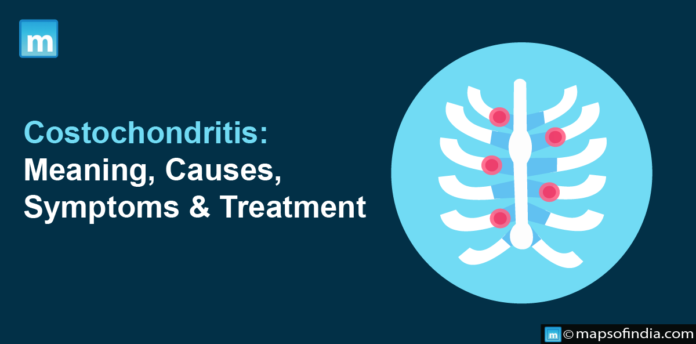Costochondritis is a common but frequently misunderstood illness that causes pain and discomfort in the chest area. It is distinguished by cartilage inflammation connecting the ribs to the breastbone (sternum). While costochondritis is often not a serious ailment, its symptoms can be upsetting and may mirror those of more severe conditions, such as a heart attack. Understanding the origins, symptoms, and therapies for costochondritis is critical for early detection and management.
Causes of Costochondritis:
- Physical Trauma: A fall, accident, or direct hit to the chest can cause inflammation in the costochondral joints.
- Repetitive motions: Activities or vocations that require repetitive chest motions, such as heavy lifting or athletics, might strain the costochondral junctions and cause inflammation.
- Respiratory Infections: Inflammation caused by viral or bacterial respiratory infections, such as a severe cough or pneumonia, can sometimes result in costochondritis.
- Arthritis: Because of the underlying inflammatory processes, those with rheumatoid arthritis or ankylosing spondylitis may be more prone to developing costochondritis.
- Joint Infections: Infections in the costochondral joints can cause inflammation and pain in rare circumstances.
Symptoms of Costochondritis:
The most common symptom of costochondritis is chest pain, which can be mild to severe. The pain is usually localised and can be felt on either side of the breastbone. Among the most common symptoms are:
- Severe, Stabbing Pain: Costochondritis is frequently severe and stabbing, making it very painful, especially during movement or deep breathing.
- Tenderness: The affected area may become sensitive to touch, and pressing the chest may aggravate the pain.
- Movement-Induced Pain: Chest movement, such as coughing, sneezing, or even deep breathing, may aggravate the pain.
- Pain Relief Through Rest: Resting and avoiding motions that strain the chest can provide relief.
- Mimicking a Heart Attack: The discomfort of costochondritis can be misinterpreted as a heart attack, causing fear and panic in certain people. It is critical to get medical attention to rule out more serious cardiac issues.
- Swelling and redness: In some circumstances, the affected area may experience swelling and redness
Treatments for Costochondritis:
The treatment of costochondritis aims to alleviate pain and inflammation while addressing any underlying factors contributing to the condition. The following approaches are commonly used:
- Pain Relief: Over-the-counter pain relievers such as ibuprofen or naproxen can help reduce pain and inflammation. Acetaminophen can also relieve pain, although it has no anti-inflammatory qualities.
- Rest and Activity Modification: Resting the chest and avoiding activities that increase pain can help healing.
- Hot or cold compresses: Applying heat or cold packs to the affected area can relieve pain.
- Physical Therapy: Under the supervision of a physical therapist, engaging in focused exercises and stretches can assist in improving chest flexibility and strength, minimising the burden of costochondritis.
- Local Anesthetic Injections: In more severe cases, a doctor may prescribe corticosteroid injections or local anaesthetic injections to the inflamed area to provide instant relief.
- Treatment of Underlying disorders: Treating the underlying cause of linked medical disorders such as arthritis is critical for long-term management.
- Breathing Techniques: Deep breathing exercises and strategies to relieve strain on the chest can assist in managing pain during episodes of costochondritis.




